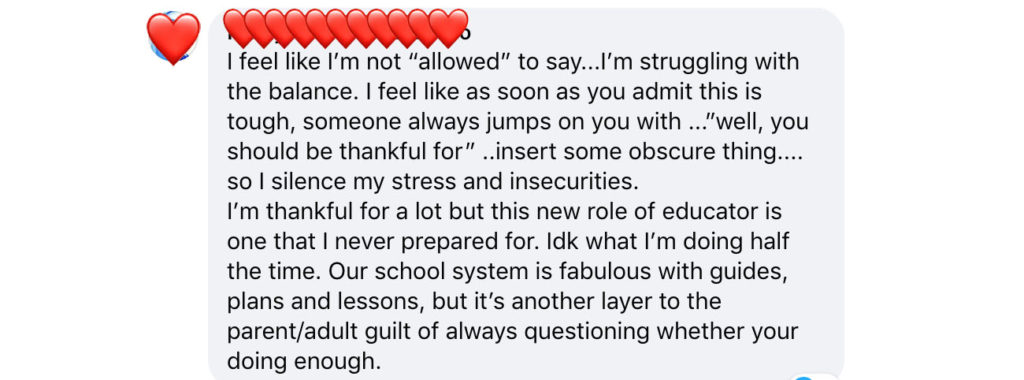TRIGGER WARNING: NEW, EDITED CONTENT INCLUDES MENTION OF SUICIDE
I am a huge advocate of and believer in the power of positive psychology.
But there is a line to draw when it comes to positivity, and on the other side of that line is what we call “toxic positivity”.
Toxic positivity refers to the concept that keeping positive and ignoring the negative is the right outlook to have. It means only focusing on positive things to avoid any negative emotions.
EDIT TO ADD: Since writing this, my family experienced a painful example of what makes this so very, very toxic.
We discovered my Aunt took her own life.
When my mother called me crying to tell me what happened, she said that this news hurt so much more than when my Grandfather passed in February.
That’s because no one saw it coming.
My mother and her sisters have a group chat where they check in with each other, and whenever they asked my Aunt how she was doing, she would say things were good, and she’s working hard.
She put a positive, strong face out into the world, masking the negativity she was feeling.
Obviously there is more going on here when we’re dealing with depression, but what she was doing is also an example of toxic positivity.
She only wanted the world to see her life as positive and hid the negative.
Shame is often a huge culprit in us keeping our pain to ourselves. We’re afraid to be judged, afraid no one will listen or care, afraid we won’t be understood.
So the negative is hidden, with positivity shining in its place.
That’s why this post is even more meaningful and impactful to me personally, and why I think you should give it a read.
If you’re thinking about suicide, are worried about a friend or loved one, or would like emotional support, the National Suicide Prevention Lifeline network is available 24/7 across the United States.
1-800-273-8255
Some people exhibit toxic positivity by portraying themselves as being happy no matter what. Whether consciously or unconsciously, they have blinders on to avoid all negative feelings.
Others experience toxic positivity from friends, family or even strangers who are trying to be helpful.
Right now, in the time of a global pandemic, toxic positivity can be truly damaging.
On top of massive changes and uncertainty, some households are dealing with unemployment. Others have sick family members. And most parents are trying to figure out how to work while also teaching their children, and it’s a lot!
A mom on Facebook posted the other day, “I feel like I’m not ‘allowed’ to say… ‘I’m struggling with the balance’. I feel like as soon as you admit this is tough, someone always jumps on you with… ‘well, you should be thankful for… insert some obscure thing’ so I silence my stress and insecurities.”


We all know those “good vibes only” people. The people who, no matter what the situation, will say things like “don’t worry, be happy” or “everything happens for a reason”.
Or maybe you are that person, the one who hates seeing people in pain so you have a positive spin for any negativity (this is the bucket I often fall into).
This post is for all of us – for those coping with difficult times, for those dealing with toxic positivity, and for those who just want to help.
Why do we do it and why is toxic positivity harmful?
It’s only natural to want to avoid uncomfortable emotions; we’re innately geared to run from pain. However, we have a wide spectrum of emotions for a reason. Ignoring or suppressing a set of emotions is denying a genuine human experience.
Toxic positivity is a problem because ignoring your issues doesn’t solve anything. It makes them escalate, and you never address what is actually making you unhappy.
A study has found that when we accept our negative emotions rather than rushing to change them, we experience less negative emotions over time, leading to greater psychological health and more emotional resilience.
“People who accept [negative] emotions without judging or trying to change them are able to cope with their stress more successfully,” says Brett Ford, the study’s lead author and assistant professor of psychology at the University of Toronto.
“It might sound counterintuitive, but if we accept our negative emotions, we actually create a greater and healthier change—without pressuring ourselves to change at all.”
I believe humans are naturally good and caring people. We want to help and make people feel better, so we have good intentions when we offer up (usually unsolicited) positivity as a response to someone’s pain.
But not only is avoiding afflicting feelings an unhealthy tactic, toxic positivity leads to a host of counterintuitive results.
Toxic positivity disconnects us from others and leads to shame.
When someone is venting their frustrations, they want to be heard and to have their feelings validated. If the response they get to sharing their pain is “just let it go and you’ll be happier” it leaves them feeling alone and not understood.
When we open up to someone, we want empathy. Rarely are we asking for someone to solve our problems for us. We want someone to say “you’re upset, I understand”.
Without that understanding there is a lack of connection, and connection is what we’re looking for as we talk about our problems.
Disconnection from others can lead to shame.
Those invalidated feelings can make us feel alienated and alone, which is the breeding ground for shame. It makes us feel like we’re not supposed to have these feelings, especially when someone says “think of all the people that have it worse off than you”.
Sure, plenty of other people do have it worse off, and it can sometimes be helpful to remember this for perspective, but it does not nullify how we feel at the moment.
In the case of the mom on Facebook who posted that she doesn’t feel like she’s “allowed” to share how she really feels for fear of people’s toxically positive replies, she is left feeling isolated, unheard, and her true emotions invalidated.
In reality, by sharing how she feels, what she is looking for is connection and validation.
We are allowed to have our own feelings about what is happening in our lives – regardless of what is happening in other people’s lives.
Focusing only on the positive can lead to suppressed emotions.
As mentioned earlier, it’s healthy to accept our negative emotions because it leads to prolonged resilience and an ability to better cope with stress.
Ignoring our negative feelings leaves our issues unresolved and only suppresses how we truly feel. “Ignore it and it will go away” only works with trick-or-treaters (if they don’t have a carton of eggs, that is!).
Emotions are the energetic manifestation of our thoughts. It’s how we physically experience the thoughts in our head. We want to disregard our negative emotions because we don’t like how they feel.
But since our feelings are simply a representation of our thoughts, ignoring them doesn’t make them go away because we aren’t addressing the root cause – what we’re thinking.
Suppressed emotions are damaging to our health.
Not only are we not solving our problems by ignoring these feelings, suppressing our emotions can cause greater problems to our health.
In fact, a 2013 Harvard study showed that people who bottled up their emotions may actually be increasing their chance of premature death by more than 30%, with their risk of being diagnosed with cancer increasing by 70%.
I think by now, most of us are aware of the mind-body connection, which is also a likely reason why we push positivity on ourselves and others.
But that positivity is an end goal, and toxic positivity is an ineffective attempt at taking a shortcut.
When you find yourself using toxic positivity towards others, do this instead.
- Listen, reflect and validate their feelings. The greatest way to connect and make someone feel heard is to empathize with them. Make them realize that you understand how they are feeling – not by making it about you and responding with a time you experienced something you think is similar – but by reflecting back what you are hearing.
I continually have to remind myself to not use toxic positivity on my husband, and the best reminder for me is that when I vent to him, all I want is for him to listen to me and say “oh wow, that sucks, I see why you feel that way.”
That’s it. Not “look on the bright side”, not “here’s how you can fix that problem” and definitely not “you shouldn’t be upset because…”.
- Ask questions. Of course you want to help! But unless someone is asking for help or asking for positive vibes, they probably don’t want it or just aren’t ready yet.
Maybe you sense that this person is really stuck in a spiral of negativity and it’s causing them harm and holding them back.
After spending some time making them feel heard, you can start to shift their negative thinking to the positive by letting them find it on their own. A benign way to do this is by asking questions. You can try asking things like:
- I know there’s a lot that could go wrong. What could go right?
- What’s one small step you can take?
- Is there something we can do today that you would enjoy?
- How can I help?
If you are using toxic positivity on yourself to run from your feelings, do this instead.
- Mindfully recognize what you are feeling. Sounds simple, but it’s all too easy to be blinded by the spiral of emotions you are in. Notice and label what you are feeling using curiosity over judgment. It could look like this, “Oh, I’m feeling angry because I want to get work done, but the kids are being rambunctious.”
- Validate your feelings. Try talking to yourself like you would someone you love and care about. “It’s natural to feel angry when things don’t go my way. I give myself permission to feel angry right now.”
- Feel, pause and reset. Take a few moments to allow yourself to feel your feelings, then recalibrate with some deep breaths, go for a walk, meditate, exercise, whatever is helpful for you and within your control at the moment.
- Plan and act – if you can. If there is something within your control to help remedy the situation, do that. We only have control over our own actions and thoughts. So if there is something you can do, like asking your significant other for help, then ask.
- THEN reframe with a neutral or positive thought. If there isn’t any action you can take at the moment, the only other thing you have control over is your thoughts. Once you’ve taken time to acknowledge, validate and feel your feelings – if you’re ready – step outside negativity by reframing the situation. Ask “what’s another way of looking at this?”
Jumping straight to positivity can be a huge leap right off, so it may be easiest to start by going to neutral by thinking something like: “I accept the circumstances as they are and need to re-evaluate my expectations in order to be less stressed.”
Or try a positive spin like, “I may not be able to get the work done that I want, but I get to spend more time with my kids right now.”
But please, still be positive!
These aren’t hard and fast rules, and our emotions, situations and solutions are not at all black and white. So of course, still share your positivity! Someone struggling may read it and be inspired, or have their troubles put into perspective.
The point of calling out “toxic positivity” is a reminder to connect, listen and validate one another and our feelings instead of hiding from them or pretending they don’t exist.
It’s hard, but in the long run, being brave enough to allow ourselves to feel our negative emotions is a sure path to resilience.
For the record, I personally don’t care for the term “toxic” positivity. While it’s not a helpful practice, it has a good intent behind it, and no one intends to be harmful by doing it. So in my book, that shouldn’t be considered “toxic”. If I were to rename it, I would call this practice “unhelpful positivity”.
Where to go from here:
- Work with me 1:1: For leaders and parents feeling lost trying to grow and heal on their own, ready for a guide on their journey out of anxiety into the happiest, most Zen-Badass version of yourself from the boardroom to the family room.
- 21 Day Meditation-in-Action emotional transformation (now only $37). In as few as 4 minutes a day, learn how to retrain your mind for resilience, peace and focus.
- Free Training – Learn the 4 Shifts to Ease Anxiety and Find Your Inner Zen-Badass: Access the free mini-but-mighty Graceful Resilience® training to learn the skills to become calm, confident and in control over your emotions so your career and relationships thrive.






Article Comments